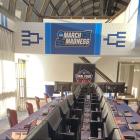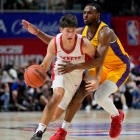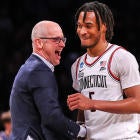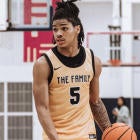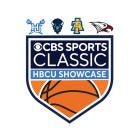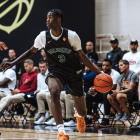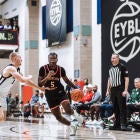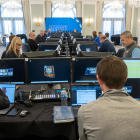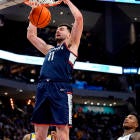Only eight days ago -- on Sunday, March 8 -- NCAA senior vice president of basketball Dan Gavitt said on CBS that the NCAA intended to have a Division I Men's Basketball Tournament in 14 cities with fans in attendance for every site, every game.
Four days (about 100 hours) later, the NCAA Tournament along with every NCAA winter and spring championship was canceled.
"I said that very definitively and with great confidence -- and believed that all the way through Monday, probably Tuesday -- but man, the rapidity with which all of this evolved over the course of the week was mind-boggling on the inside," Gavitt told CBS Sports after the cancellations.
The spread of the coronavirus -- and the necessary precautions put into place to curb its scatter -- have forced a full-blown halt of sports across the country and in many places around the globe. For college basketball, the termination of both big hoops tournaments was a no-other-choice last resort that symbolized the seriousness of this unprecedented time in world history.
As we move farther way from the Board of Governors' decision on Thursday to kill off the NCAA Tournament, that determination feels more and more obvious and less and less controversial; frankly, we're already at the point where it's a no-brainer. But in the days and hours leading up to it, the NCAA was trying to remain levelheaded while attempting to salvage its biggest and best event (and it's overwhelming primary producer of revenue).
It also completed this process with more nimbleness than maybe it's been given credit for. With help from those who were in the room, here is an inside view to get a sense of what it was like at the highest levels in the 40-or-so hours that led up to the moment the NCAA Tournament died.

Tuesday, March 10
Evening
All 10 members of the Division I Men's Basketball Committee and other senior NCAA staff convene in New York City for their annual big dinner before officially gathering to select and seed the 68 teams who will participate in the NCAA Tournament. It's always served as a joyous and auspicious get-together that doubles as a launching pad for the committee's daunting-but-enthusiastic duty to build the bracket.
The only significant outright cancellations in major American sports at this point are the Ivy League banning its postseason tournament earlier on Tuesday and tennis' BNP Paribas Open in Indian Wells, California, which shut down on Sunday
The NCAA has been relying upon the expert advice of its recently formed COVID-19 panel since March 3, so exactly a week's time.
By the end of Tuesday night there is unavoidable concern over the future of the NCAA Tournament -- but not yet in regard to whether it will be played. At this stage, the question instead is whether the tournament will be able to host fans at the First Four, plus all second-weekend sites and the Final Four. This concern was accelerated due to Ohio Gov. Mike DeWine strongly suggesting just hours before on Tuesday that no indoor sporting events be held with fans. It's also raised alarm bells due to the fact that the conference tournaments for the MAC (in Cleveland) and the Big West (Anaheim, California) announced hours earlier that no fans would be allowed to attend their respective tournaments.
Before the night is over, informal contingency plans are being hashed out based on the expectation that NCAA Tournament sites in Ohio are unlikely to allow the general public in. Discussions begin about moving some sites to different states, in seemingly less-affected areas that would still prohibit fan attendance.
Wednesday, March 11
Morning
By early morning, the NCAA is of course in contact with its medical advisory panel. The panel was monitoring trends and actions to quarantine from around the world, including China, South Korea and Italy. Also important to know: it's on this day that the World Health Organization elevates coronavirus from an epidemic to a pandemic.
"By Wednesday morning the advisement we were getting, almost overnight, was that the large-scale gatherings were a problem in this country and having the tournament with fans was not advisable," Gavitt said. "Literally at 7:30 in the morning on Wednesday was the first time I heard that. That came as a game-changer and that led to later that day the announcement that we would continue to hold the tournament but only with select family members in attendance."
Just after 9 a.m. inside spacious suite 4320 on the 43rd floor of the Times Square Marriott Marquis, the selection committee returns after breakfast to go through typical non-selection business before the scheduled process of initial ballot selections. Remember, at this point of the week the tournament is still very much on. J.D. Collins, the coordinator of officials for the NCAA, introduces a document with all 100 officials (and nine on standby) who have been selected to work the tournament, amid some other items such as addressing potential for interrupted games and possible forfeits.
There is already unrest in the room due to the unavoidable phone calls Gavitt must take as the tournament begins to morph. He is constantly pulled in and out of the committee room because of calls, which is not how things normally go. In all his years with the NCAA and during selection week, he's been embedded with the committee and crucial NCAA senior staff throughout the process.
With increasing national uncertainty surrounding coronavirus, the NCAA decides shortly before 10:30 a.m. to cancel its regularly scheduled media teleconference for later that afternoon with committee chair Kevin White. Due to Gavitt scheduled inclusion on a 2 p.m. call with NCAA President Mark Emmert, the NCAA Board of Governors and other high-ranking NCAA officials, the decision's made to not put White in a spot with the media where the facts could literally change any moment.
At this stage, with some uncertainty around the country -- speculation has quickly increased over not allowing fans to sporting events in all sports -- the committee breaks for lunch.
Afternoon
After lunch, as coronavirus-related news continues to flow, committee members are unable to even begin the proper selection protocol because at this point everyone is waiting on official word from the Board of Governors call before taking next steps. It is effectively ineffective to try and attempt to pick teams for the field of 68 right now.
One such example that touches college athletics: at 12:42 p.m. ET, due to dozens of campuses closing indefinitely across the country, the CBI announces its tournament is canceled. During the Board of Governors call, shortly after 2 p.m., the Golden State Warriors announce they will fall in line with new local guidelines from health and government officials by restricting fans from attending home games for the foreseeable future.
By 2:45 p.m. ET, the governor of Ohio -- in less than 24 hours time -- has gone from suggesting no mass gatherings be allowed in his state to announcing he will sign an executive order barring mass gatherings including the First Four in Dayton and first and second round NCAA Tournament games in Cleveland. All these pieces of information are relayed to the committee, which is still tending to various other matters.
At 4:31 p.m. the first major headline in college basketball lands. Emmert sends out a statement that fans will not be allowed to attend the men's and women's tournaments.
NCAA President Mark Emmert statement on limiting attendance at NCAA events: https://t.co/GrPbmZx5N6 pic.twitter.com/PFFh9htixR
— Inside the NCAA (@InsidetheNCAA) March 11, 2020
In a detail that may eventually be lost to history, the NCAA in fact beats the NBA, NHL, Major League Baseball and its spring training, and all other organized team sports, to announce plans to hold games without fans in attendance.
It also beats all NCAA conferences -- with the exception of the Ivy League, the MAC and the Big West -- on restricting fans from attending. A short while later, with the understanding now public that fans will not attend the Final Four, Emmert tells the Associated Press that the NCAA is looking into if it can move its biggest single-site event out of Atlanta's Mercedes-Benz Stadium and into nearby State Farm Arena.
Across the country, the news of the NCAA's decision signifies the seriousness to the general public of the coronavirus pandemic. The NCAA is indeed acting fairly effectively, efficiently and intelligently. The COVID-19 advisory panel is exceedingly helpful behind the scenes in establishing the boundaries, assisting key school presidents in understanding a quickly evolving situation.
Amid all this, Gavitt and his team are making calls and brainstorming on how to salvage a 68-team tournament that could require relocation of multiple regional and subregional sites. Dayton, in this moment, is considered safe because it still can have the First Four without fans.
But the notion of first- and second-weekend sites in the same building becomes something seriously considered.
"The ones we were thinking most about that time were Kansas City, because the Big 12 tourney was going on and available and then Kansas City was also beneficial because they could have also hosted a first and second round," Gavitt said. "Another alternative site for the first and second round was Indianapolis' Lucas Oil Stadium because they were already hosting regionals, had the court and could potentially host the first weekend."
More than a dozen other alternatives are listed, but Kansas City and Indianapolis are the two that were thoughtfully investigated in a preliminary sense. There is still hope, though, because not all leagues have abandoned original plans. Shortly before 5 p.m., Big East Commissioner Val Ackerman announces that her conference's games for the evening session will still be open to the ticket-buying public.
Evening
Though the Big East has announced its first-round games will go on as scheduled with fans in attendance, the Big Ten and Big 12, within minutes of each other and shortly before 6:45 p.m. ET, opt out of allowing fans in the building. College basketball in the month of March grows more uncertain by the hour and the committee still has not done any work pertaining to selections. Not a single team is into the field of 68 by 7 p.m., which is unprecedented in the history of the committee in its current selection protocol.
By 8 p.m., the ACC Tournament has also closed its doors to the public. No one realizes it, but the sports world is about to change permanently in less than 90 minutes. The committee learns shortly before 9 p.m. that the Pac-12 has also banned fans from attending its tournament. There are a dozen other coronavirus-related headlines worldwide in sports that have turned the news cycle into a minute-by-minute development.
Then, at 9:27 p.m. ET, it's reported that Utah Jazz center Rudy Gobert has tested positive for coronavirus after players preparing for Utah's game at Oklahoma City are pulled off the floor and the game is postponed. Four minutes later, the NBA officially suspends its season. Within an hour of that, the National Association of Basketball Coaches, a body representing more than 2,500 coaches in all 50 states, announces its Final Four convention is off. Conference tournament games continue to play out, but by this point the committee has officially adjourned any tournament-related business for the evening.
It's become an unforgettable day in the history of American sports -- and is a precursor to the inevitable in less than 24 hours.
In Indianapolis, Fred Hoiberg is coaching Nebraska against Indiana. Cameras catch him wiping his nose and forehead, dropping his neck and looking unwell. Hoiberg leaves the bench early in the Cornhuskers' loss to Indiana. United States Basketball Writers Association president Malcolm Moran is sending text updates to NCAA staff from Indy, detailing what he's seeing: Hoiberg leaving Bankers Life Fieldhouse by wheelchair.
For nearly 90 minutes, it's, Now what? With the Gobert news causing worldwide headlines, Hoiberg's health forces the question: If he's contracted coronavirus, can we even play an NCAA Tournament? Indiana is a projected bubble team and a lot of questions stem from this. For more than an hour there is concern and uncertainty over whether Hoiberg has contracted COVID-19. At 12:43 a.m. ET, Nebraska announces Hoiberg instead has influenza A.
Update on Head Coach Fred Hoiberg pic.twitter.com/sbe2pACeJE
— Nebraska Basketball (@HuskerHoops) March 12, 2020
The fate of the bracket has nonetheless taken a turning point. Committee members head back to their hotel rooms after midnight. NCAA staff continues to huddle up and talk through timelines. Gavitt sees his beloved tournament tied to the tracks with a train traveling at the speed of sound heading right for it.
"When the NBA announcement came out on Wednesday night that Rudy Gobert had been infected and those teams had been infected in Oklahoma City, that was a truly pivotal moment in my mind," Gavitt said. "I lost a lot of, not outward confidence, but inward confidence. Let's just say this: I thought immediately at that point we had a serious race against time to get this tournament in."
It's decided that, barring something calamitous in the next eight or nine hours, the committee will fulfill its charge and begin the selection process first thing in the morning.
Thursday, March 12
Morning
Gavitt, David Worlock and JoAnn Scott -- with some counsel from L.J. Wright, Tammy Lee and J.D. Hamilton -- put together an emergency plan, if necessary, for a condensed 16-team tournament to take place over five consecutive days in Atlanta in slightly over a week from now: March 19-23. It's an inspired and intriguing improv plan.
The committee considers, but taking into account so many moving parts, ultimately votes it down.
It's before 10 a.m. and more than 50 conference-tournament games are still scheduled to be played throughout the day. The committee realizes it has to put forth an effort to select the field, and that process begins. Initial ballots are cast by all 10 members and when that process is through, the 2020 NCAA Tournament has 31 teams selected as at-larges and 13 others that are in via automatic qualifier. (Some of the at-larges would have inevitably become AQs, opening up more at-large spots to be finalized on Saturday and Sunday.)
A large board is displayed with all teams in the field. For about maybe about 60 minutes, weirdly enough things actually feel mostly normal.
It's as far as the committee will get in its process. Not a single team is even placed on a seed line.
Across the country, like a rolling tide, the sport falls about. The American Athletic Conference, the Big Ten, ACC, Big 12, SEC, Pac-12 and Atlantic 10 conferences announce they have canceled their tournaments, mostly between 10:30 a.m. and noon. The calculus has changed for good.
Surprisingly, across town at Madison Square Garden, the Big East prepares to tip its quarterfinal game between St. John's and Creighton.

Afternoon
A surreal scene sets in, as the Big East plays out the final Division I men's tip of the season -- a game that would not last more than 20 minutes because it was canceled at halftime with St. John's leading Creighton 38-35. As this is happening, the selection committee is of course taking into account everything that is going on, and what's inevitable to come, because they are also in contact with NCAA officials and those who represent their schools and conferences. Campuses are now closing practically by the minute.
Being that the committee is comprised of athletic directors and conference commissioners, they are also dealing with the coronavirus crisis in their respective cities/regions. The toughest informal discussions about having to cancel the men's and women's tournaments have been bubbling for hours and are now reaching a boiling point.
At 1:49 p.m., Duke announces that all its teams are suspended from athletic competition. Committee chair Kevin White is the athletic director at Duke -- he'd been pulled out of the room earlier because of this as well.
Duke Athletics Suspends Activities Indefinitely
— Duke Athletics (@DukeATHLETICS) March 12, 2020
🗞️ https://t.co/a2mx0n9QYR#GoDuke pic.twitter.com/y9UjTw8CDT
To many in the public, the Duke news was the straw in the wind; once it was known Duke wasn't playing in the NCAA Tournament, it was over-over.
"Even Thursday afternoon just before the board call I was probably in somewhat of a state of denial, not irresponsibly so, but our mindset all along was, 'We're going to make this happen,'" Gavitt said. "For 81 years this has happened and under any conditions we will contingency plans, pivot and change and it will be played."
But by this point Gavitt is pretty certain the end is an hour or so away.
The jets, figuratively speaking, are scrambled once again at the Board of Governors level to get every person required on a conference call to determine the fate of all pending NCAA championship events. It's determined that the call will happen at 3 p.m. Two crucial people who have been assisting the NCAA for a week-plus in regard to COVID-19 decision-making are NCAA chief medical officer Brian Hainline and former United States Surgeon General Vivek Murthy, who doubles as a COVID-19 advisory panel member and sits as an independent rep on the Board of Governors.
"It was absolutely full information-sharing going on there," Gavitt said, being sure to cite both men and their importance from the start.
The NCAA in fact was both fast-acting and responsible in getting valid information, understanding the facts, observing trends of the spread of coronavirus and making informed decisions that had billions of dollars in ramifications.
"It happened as fast as it could happen," Gavitt said.
Gavitt leaves the committee room at 3 p.m. and doesn't emerge until after the press release lands 76 minutes later. All 20 Board of Governors members, plus Emmert and select other high-ranking NCAA staff, discuss a number of confidential specifics before making the unanimous vote to cancel all NCAA-sanctioned events in winter and spring sports immediately.
Given the connections those on the selection committee have (the commissioners of the Mountain West, SWAC, Southland and Atlantic 10 are members, for example), and because most Board of Governors members are presidents of universities, official word via text message fluttered in very quickly to those in the committee room. This is how many a conference commissioner across the country finds out, too.
At 4:16 p.m., the NCAA pushes send on its official release to nix the 2020 Men's and Women's Tournaments, making history in the process.
NCAA cancels remaining winter and spring championships: https://t.co/p4vCzvzmvo pic.twitter.com/yqAHak4HO5
— Inside the NCAA (@InsidetheNCAA) March 12, 2020
At 4:58 p.m., the CAA announces an official who worked its tournament tested positive for coronavirus more than 72 hours after working his game. I asked Gavitt if this information was known by anyone high-ranking within the NCAA prior to the Board of Governors call. It was not.
"If all things stayed this same all day [Friday] and games began at 12 and games were finishing, second games were starting and news broke that a game official at CAA got coronavirus, the wheels would have been in motion [to cancel the NCAA Tournament]," he said. "The tournament news was official and then we got at that alert."
Postponing the NCAA Tournament is never seriously discussed because of a litany of logistical issues, plenty of which were foreseen by athletic directors, committee members and school presidents days before our current coronavirus landscape was crystallized. With the cancellation of spring sports, winter sports could not be exempt. That was the No. 1 blockade. What's more, asking teams to assemble weeks if not months after their seasons ended would amount to an awkward addendum, particularly when plenty of players on tournament teams would have moved on from college to prepare for their pro careers.
Example: the Dayton Flyers of November-through-March would not be the Dayton Flyers of mid-May.
"Even just the practical nature of teams being able to go back to their campuses in some cases to practice, to train, to be allowed to be on campus was limiting at the very least for some teams," Gavitt said. "The medical advice that we've gotten all along that's driven all the decisions around championships was that we're at the front end of this coronavirus situation and it's highly likely to go weeks, possibly months, into the spring/summer, and so with the practicality of teams being able to stay together in their current roster seemed impractical. Seniors are going to start looking at their future, talented underclassmen are certainly going to start exploring their professional options. Having a tournament with teams that are no longer constituted the way they would be in March just seemed very impractical and even the ability to do that with the very serious and sad situation going on in our country."
By 5 p.m., committee members have left the room for good. Only NCAA staff is there to pick up the pieces and try to come to terms with the somewhat sudden ceasing of an American tradition: March Madness would not happen in 2020. And as we see in real-time in the aftermath of the cessation and suspension of so may sports leagues, dealing with coronavirus is going to be a months-long actuality, not a short-term rerouting.
So, with officially no NCAA Tournament bracket being released for 2020, the only image left of what could have been is the court design for this year's Final Four. One more glimpse at what could have never been.









